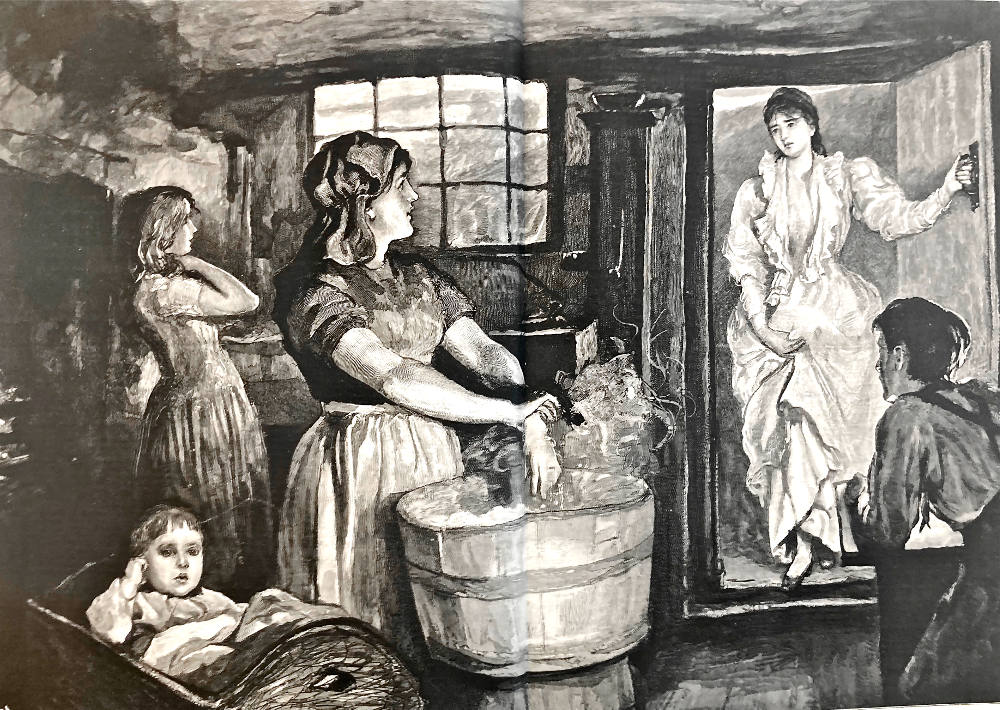
There stood her mother, amid the group of children, hanging over the washing tub by Hubert von Herkomer, RA. This large scale composite woodblock engraving, the first in the illustrated serialisation of Thomas Hardy's Tess of the D'Urbervilles, appeared in the 4 July 1891 issue of the London Graphic: double-page, horizontal: 29.5 cm high by 42 cm wide (11 ⅞ inches high by 17 inches wide). Pp. 12-13 (The first instalment begins on p. 11 and ends on p. 14.). [Click on the illustration to enlarge it.]
Passage Illustrated: Tess, dressed fashionably, returns to the Durbeyfield Cottage
The interior, in spite of the melody, struck upon the girl’s senses with an unspeakable dreariness. From the holiday gaieties of the field — the white gowns, the nosegays, the willow-wands, the whirling movements on the green, the flash of gentle sentiment towards the stranger — to the yellow melancholy of this one-candled spectacle, what a step! Besides the jar of contrast there came to her a chill self-reproach that she had not returned sooner, to help her mother in these domesticities, instead of indulging herself out-of-doors.
There stood her mother amid the group of children, as Tess had left her, hanging over the Monday washing-tub, which had now, as always, lingered on to the end of the week. Out of that tub had come the day before — Tess felt it with a dreadful sting of remorse — the very white frock upon her back which she had so carelessly greened about the skirt on the damping grass — which had been wrung up and ironed by her mother’s own hands.
As usual, Mrs. Durbeyfield was balanced on one foot beside the tub, the other being engaged in the aforesaid business of rocking her youngest child. The cradle-rockers had done hard duty for so many years, under the weight of so many children, on that flagstone floor, that they were worn nearly flat, in consequence of which a huge jerk accompanied each swing of the cot, flinging the baby from side to side like a weaver’s shuttle, as Mrs. Durbeyfield, excited by her song, trod the rocker with all the spring that was left in her after a long day’s seething in the suds. [Book First: "The Maiden," Chapter III, p. 14]
Commentary: Directing the Reader to the Melancholy Curtain of the Instalment
The first instalment of "Thomas Hardy's new serial story" (as the magazine describes the twenty-four part novel) begins on page 11 for The Graphic for 4 July 1891, and this double-page illustration occurs on the two facing pages immediately following the initial page of the story; however, the incident depicted does not occur until the end of the first number, half-way through Chapter III. Herkomer employs a direct quotation to direct the reader's attention towards a moment (the homecoming of the fashionably dressed oldest daughter of the house) that seems neither particularly suspenseful nor thematic. And yet the reader must read it proleptically, examining all the details of the cottage interior and comparing the workhorse mother with her beautiful eldest child. The substance of the cottage scene comes directly from the serial instalment, and realizes emphatically the rocking cradle, the housewife's singing a country "ditty," and the "unspeakable dreariness" of Monday morning clothes washing. But the cradle is not violently rocking as in Hardy's description, and Herkomer focusses Tess's fashionable dress to underscore the separation between dialectal Joan and her formally school daughter who speaks "National school" standard English. To the left is workaday reality of washtub, cradle, and domestic enslavement; to the right is the daughter in a holiday idyll suddenly shattered by the squalor of the Durbeyfield home.
Note: The next few illustrations in this serialisation are by different illustrators. See the complete list.
Scanned image and text by Philip V. Allingham. Formatting by George P. Landow. [You may use this image without prior permission for any scholarly or educational purpose as long as you (1) credit the person who scanned the image and (2) link your document to this URL in a web document or cite the Victorian Web in a print one.]
Bibliography
Allingham, Philip V. "The Original Illustrations for Hardy's Tess of the D'Urbervilles Drawn by Daniel A. Wehrschmidt, Ernest Borough-Johnson, and Joseph Sydall for the Graphic (1891)." The Thomas Hardy Year Book, No. 24 (1997): 3-50.
Allingham, Philip V. "Six Original Illustrations for Hardy's Tess of the D'Urbervilles Drawn by Sir Hubert Von Herkomer for the Graphic (1891)." The Thomas Hardy Journal, Vol. X, No. 1 (February 1994): 52-70.
Hardy, Thomas. Tess of the D'Urbervilles in the Graphic, 1891, 4 July-26 December, pp. 11-761.
Jackson, Arlene M. Illustration and the Novels of Thomas Hardy. Totowa, NJ: Rowman and Littlefield, 1981.
Vann, J. Don. "Tess of the D'Urbervilles in the Graphic, 4 July — 26 December 1891." Victorian Novels in Serial. New York: MLA, 1985, pp. 88-89.
Created 14 December 2000
Last modified 30 April 2024